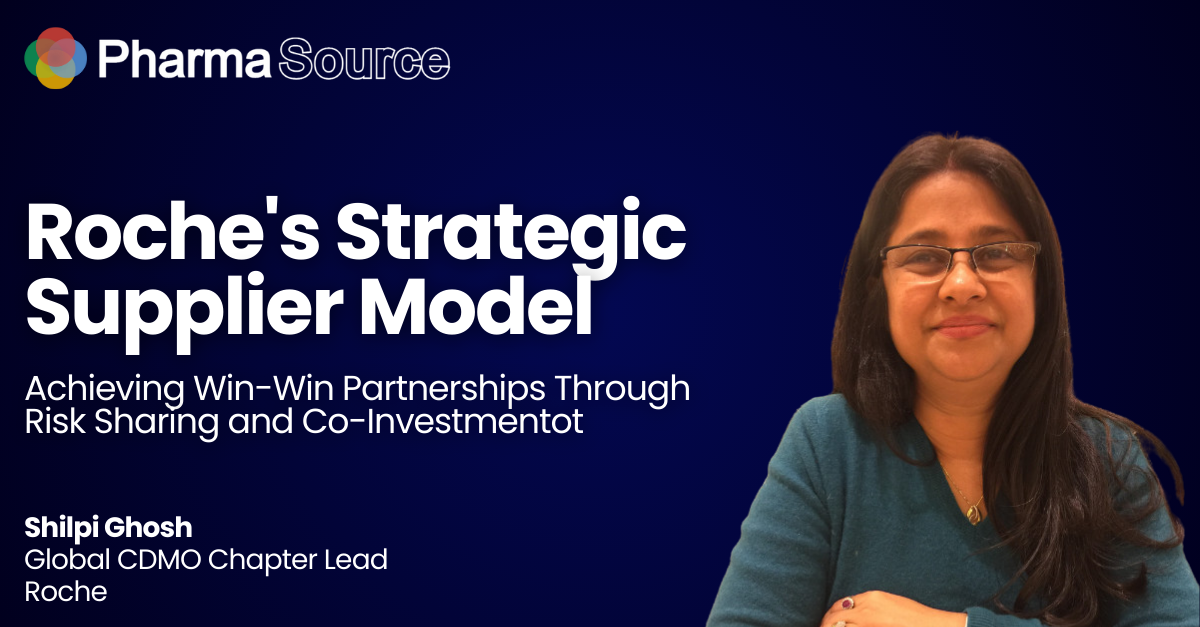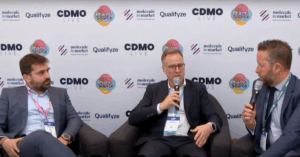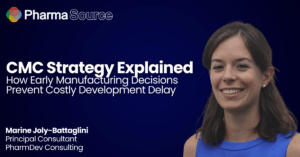“A strategic partnerships is not a transactional relationship – it’s a partnership that should last. If we incentivise through co-investments and risk sharing, the partner can grow their business while enabling us to achieve cost and volume targets.” – Shilpi Ghosh
Shilpi Ghosh, who leads Roche’s global CDMO operations, brings extensive expertise from chemical engineering and supply chain leadership across multiple continents. She oversees commercial aspects of Roche’s external manufacturing strategy, managing relationships with multiple external manufacturers globally.
In the latest PharmaSource podcast episode, Shilpi explains why getting CDMO relationship management right is a key strategy for driving down costs, improving operational efficiency, and building sustainable partnerships that deliver results from early development through commercial launch.
Building Strategic Development Partnerships
Roche’s investment in its new RNAHub in Basel demonstrates how internal capabilities and external partnerships must work together. The hub focuses on oligonucleotide development and delivery, yet manufacturing remains entirely outsourced.
“The RNAHub focuses on early-stage development. We don’t have major internal oligonucleotide capabilities in terms of manufacturing, so we completely rely on CDMOs”
This strategy reflects Roche’s approach of investing in core development expertise whilst leveraging external manufacturing excellence.
Roche has established a strategic partnership in South Asia with joint investments to support oligonucleotide manufacturing. The company is expanding geographically, with discussions underway for North American partners as portfolio and volume increase. This geographic diversification addresses both capacity needs and supply chain resilience.
The preference is always to select a partner during development who can carry through to commercial readiness. “You avoid a tech transfer, and there’s familiarity and interest for building a relationship because you’re starting all the way from development,” she notes. This approach maximises the return on both parties’ investments in the relationship.
Organisational Structure to Optimise CDMO Management
Roche has experimented with different organisational approaches to manage CDMO relationships effectively. The company has tested technology-focused structures (small molecules vs large molecules), end-to-end product lifecycle approaches, and regional structures.
“There’s no ideal organisation structure. You pick the one that best suits you at that point of time,” Shilpi observes. Currently, the company is transitioning from end-to-end lifecycle management back toward technology-focused organisation.
A sophisticated governance structure underpins these relationships, from joint management teams at the operational level through to executive steering committees for strategic suppliers. Function-to-function matching ensures quality speaks to quality, and manufacturing science teams interact with their counterparts, all under site manager oversight.
Sustainability Integration from Development Through Commercial Stages
Roche has committed to reducing carbon footprint by 50% by 2030, requiring active engagement with CDMOs on sustainability initiatives. The company evaluates sustainability capabilities from the very start of product selection.
“When we select a CDMO for development, even at the development stage, we look at their technical capabilities, which will allow them to handle sustainability in the future,” Shilpi explains.
The focus is weighted on drug substance manufacturing, where solvent and water usage create the largest carbon emissions. Roche works with CDMOs on developing generation two processes, such as liquid phase processes for oligonucleotides and peptides instead of solid phase processes, dramatically reducing solvent consumption.
The company also educates CDMOs, particularly in Asia, helping them understand sustainability requirements and develop capabilities. “Not all CDMOs are at the same level, so we are educating our CDMOs on how to go to the next level of sustainability,” she notes.
Digital Transformation Tackles Standardisation Challenges
Roche is implementing digital solutions to replace paper-based processes for batch records and forecasting, but faces significant industry challenges. “The biggest challenge we face is that there is no one standard digitalisation solution for the CDMO space,” Shilpi explains.
Each pharmaceutical company brings its own digital solution, creating a complex challenge for CDMOs who must manage numerous different platforms across their client base. “Every client brings a different solution to them, and they may have to live with hundreds of different solutions,” Shilpi points out. She explains that Roche is implementing SAP solutions including exchange tools with CDMOs, but acknowledges the pharmaceutical industry lags behind others in digitalisation.
AI Delivers Measurable Efficiency Gains
Roche is actively implementing AI solutions across CDMO operations, with Shilpi reporting personal experience of 60-70% time savings on routine tasks like meeting minutes and document comparisons.
The company has identified deviation management as a key AI use case, automating the transfer of supplier deviation reports directly into Roche’s quality systems.
“We are experimenting on how we can use AI to automatically input supplier deviation data into our quality systems instead of manual data entry.”
The approach focuses on selecting specific pain points, implementing solutions fully, then expanding to additional use cases rather than attempting broad implementation simultaneously. This targeted approach combines technical solutions for specific challenges with day-to-day efficiency improvements.
Global Presence and Technical Specialisation
Looking ahead, Shilpi identifies several key trends shaping CDMO requirements. The continued focus on primary care disease areas creates pressure for high volumes and aggressive cost targets, while new modalities increase in complexity.
“CDMOs should focus on technical capabilities like new modality specialisation in combination with globalisation plus efficiency improvement”
Global presence becomes essential for flexibility, addressing both geopolitical considerations and cost pressures.
The combination of geopolitical uncertainty and primary care focus means CDMOs “cannot just focus on technical capability and sit in Europe” due to both flexibility and cost requirements.











